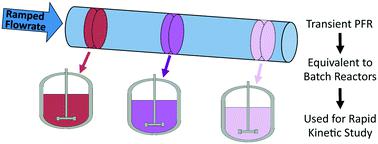当前位置:
X-MOL 学术
›
React. Chem. Eng.
›
论文详情
Our official English website, www.x-mol.net, welcomes your feedback! (Note: you will need to create a separate account there.)
Model-based design of transient flow experiments for the identification of kinetic parameters
Reaction Chemistry & Engineering ( IF 3.9 ) Pub Date : 2019-11-15 , DOI: 10.1039/c9re00342h Conor Waldron 1, 2, 3, 4 , Arun Pankajakshan 1, 2, 3, 4 , Marco Quaglio 1, 2, 3, 4 , Enhong Cao 1, 2, 3, 4 , Federico Galvanin 1, 2, 3, 4 , Asterios Gavriilidis 1, 2, 3, 4
Reaction Chemistry & Engineering ( IF 3.9 ) Pub Date : 2019-11-15 , DOI: 10.1039/c9re00342h Conor Waldron 1, 2, 3, 4 , Arun Pankajakshan 1, 2, 3, 4 , Marco Quaglio 1, 2, 3, 4 , Enhong Cao 1, 2, 3, 4 , Federico Galvanin 1, 2, 3, 4 , Asterios Gavriilidis 1, 2, 3, 4
Affiliation

|
With recent advances in automated flow reactors and online analysis techniques, transient flow experiments are attracting significant interest as methods for rapidly gathering kinetic data. However, the design of these experiments is challenging and non-intuitive. This work addresses this challenge by using model-based design of experiments (MBDoE) to design optimum transient experiments for the purpose of identifying kinetic parameters with maximum precision. Using the case study of benzoic acid and ethanol esterification with sulfuric acid as the catalyst, the flowrate and temperature of a plug flow reactor were linearly ramped in time to create transient flow experiments. Two types of experiments were conducted, one where only flowrate was ramped while all other variables were held constant, and one where flowrate and temperature were ramped simultaneously. In both cases, model-based design of experiments (MBDoE) methods were used to design the transient experiments in order to choose the initial value and ramp rate of all ramped process variables, as well as choosing the fixed value of process variables that were not being ramped (feed concentration). The model-based designed experiments were compared against equivalent experiments designed by researcher intuition and standard design of experiments approaches, such as trying to cover a wide area of the design space. It is shown that MBDoE led to significantly more precise parameter estimates, and that the identified model was then able to predict with high accuracy the outlet concentration of other experiments.
中文翻译:

基于模型的瞬态流动实验设计,用于确定动力学参数
随着自动流动反应器和在线分析技术的最新进展,瞬态流动实验作为快速收集动力学数据的方法引起了人们的极大兴趣。但是,这些实验的设计具有挑战性且不直观。这项工作通过使用基于模型的实验设计(MBDoE)来设计最佳瞬态实验,从而以最高的精度识别动力学参数,从而解决了这一挑战。以苯甲酸和乙醇以硫酸为催化剂进行酯化的案例研究为基础,对活塞流反应器的流速和温度进行了线性调整,以进行瞬时流动实验。进行了两种类型的实验,一种仅增加流量,而其他所有变量保持恒定,流量和温度同时上升的那一处。在这两种情况下,都使用基于模型的实验设计(MBDoE)方法来设计瞬态实验,以便选择所有斜变过程变量的初始值和斜率,以及选择非斜率过程变量的固定值。被增加(饲料浓度)。将基于模型的设计实验与由研究人员的直觉和实验方法的标准设计(例如,试图覆盖设计空间的广阔区域)设计的等效实验进行比较。结果表明,MBDoE可以显着提高参数估计的准确性,然后,所识别的模型便可以高精度地预测其他实验的出口浓度。基于模型的实验设计(MBDoE)方法用于设计瞬态实验,以便选择所有斜坡化过程变量的初始值和斜坡率,以及选择未斜坡化(进给)的过程变量的固定值专注)。将基于模型的设计实验与研究员直觉和实验方法的标准设计(例如,试图覆盖设计空间的广阔区域)设计的等效实验进行比较。结果表明,MBDoE可以显着提高参数估计的准确性,并且所识别的模型随后可以高精度地预测其他实验的出口浓度。基于模型的实验设计(MBDoE)方法用于设计瞬态实验,以便选择所有斜坡化过程变量的初始值和斜坡率,以及选择未斜坡化(进给)过程变量的固定值专注)。将基于模型的设计实验与研究员直觉和实验方法的标准设计(例如,试图覆盖设计空间的广阔区域)设计的等效实验进行比较。结果表明,MBDoE可以显着提高参数估计的准确性,并且所识别的模型随后可以高精度地预测其他实验的出口浓度。以及选择不增加的过程变量的固定值(进料浓度)。将基于模型的设计实验与研究员直觉和实验方法的标准设计(例如,试图覆盖设计空间的广阔区域)设计的等效实验进行比较。结果表明,MBDoE可以显着提高参数估计的准确性,并且所识别的模型随后可以高精度地预测其他实验的出口浓度。以及选择不增加的过程变量的固定值(进料浓度)。将基于模型的设计实验与研究员直觉和实验方法的标准设计(例如,试图覆盖设计空间的广阔区域)设计的等效实验进行比较。结果表明,MBDoE可以显着提高参数估计的准确性,并且所识别的模型随后可以高精度地预测其他实验的出口浓度。
更新日期:2019-11-15
中文翻译:

基于模型的瞬态流动实验设计,用于确定动力学参数
随着自动流动反应器和在线分析技术的最新进展,瞬态流动实验作为快速收集动力学数据的方法引起了人们的极大兴趣。但是,这些实验的设计具有挑战性且不直观。这项工作通过使用基于模型的实验设计(MBDoE)来设计最佳瞬态实验,从而以最高的精度识别动力学参数,从而解决了这一挑战。以苯甲酸和乙醇以硫酸为催化剂进行酯化的案例研究为基础,对活塞流反应器的流速和温度进行了线性调整,以进行瞬时流动实验。进行了两种类型的实验,一种仅增加流量,而其他所有变量保持恒定,流量和温度同时上升的那一处。在这两种情况下,都使用基于模型的实验设计(MBDoE)方法来设计瞬态实验,以便选择所有斜变过程变量的初始值和斜率,以及选择非斜率过程变量的固定值。被增加(饲料浓度)。将基于模型的设计实验与由研究人员的直觉和实验方法的标准设计(例如,试图覆盖设计空间的广阔区域)设计的等效实验进行比较。结果表明,MBDoE可以显着提高参数估计的准确性,然后,所识别的模型便可以高精度地预测其他实验的出口浓度。基于模型的实验设计(MBDoE)方法用于设计瞬态实验,以便选择所有斜坡化过程变量的初始值和斜坡率,以及选择未斜坡化(进给)的过程变量的固定值专注)。将基于模型的设计实验与研究员直觉和实验方法的标准设计(例如,试图覆盖设计空间的广阔区域)设计的等效实验进行比较。结果表明,MBDoE可以显着提高参数估计的准确性,并且所识别的模型随后可以高精度地预测其他实验的出口浓度。基于模型的实验设计(MBDoE)方法用于设计瞬态实验,以便选择所有斜坡化过程变量的初始值和斜坡率,以及选择未斜坡化(进给)过程变量的固定值专注)。将基于模型的设计实验与研究员直觉和实验方法的标准设计(例如,试图覆盖设计空间的广阔区域)设计的等效实验进行比较。结果表明,MBDoE可以显着提高参数估计的准确性,并且所识别的模型随后可以高精度地预测其他实验的出口浓度。以及选择不增加的过程变量的固定值(进料浓度)。将基于模型的设计实验与研究员直觉和实验方法的标准设计(例如,试图覆盖设计空间的广阔区域)设计的等效实验进行比较。结果表明,MBDoE可以显着提高参数估计的准确性,并且所识别的模型随后可以高精度地预测其他实验的出口浓度。以及选择不增加的过程变量的固定值(进料浓度)。将基于模型的设计实验与研究员直觉和实验方法的标准设计(例如,试图覆盖设计空间的广阔区域)设计的等效实验进行比较。结果表明,MBDoE可以显着提高参数估计的准确性,并且所识别的模型随后可以高精度地预测其他实验的出口浓度。



























 京公网安备 11010802027423号
京公网安备 11010802027423号